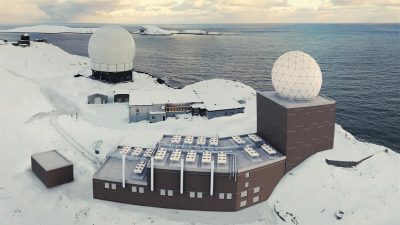Norway’s easternmost Arctic community of Vardø has long been home to surveillance and intelligence-gathering operations so important to the US and NATO, especially now with Russian tension running high. Vardø, like other areas of Northern Norway, has grown used to the presence of hush-hush facilities and their personnel amongst them, but now a local conflict has arisen over wind power.

Such conflicts are nothing new. While many Norwegians favour more investment in renewable energy than oil, few want towering turbines in their own backyard.
That’s what seems to set Vardø apart: Residents long accustomed to huge radar installations looming over their town don’t seem to mind the prospect of turbines, too, that would capture some of the most steady winds in the country and, potentially, generate much-needed electricity, income and tax revenues.
“We have Norway’s best wind power resources,” Vardø Mayor Ørjan Jensen of the Greens Party (MDG) told newspaper Klassekampen. “For us, it’s a disadvantage if it can’t be used.”
Jensen, Norway’s only mayor from the Greens Party, and his fellow local government officials support plans to build a wind power plant that could generate not only needed electricity but NOK 600 million in property tax revenue. The turbines and their operations could also help secure electric power in the remote, often stormy area, and have positive economic ripple effects in the small city that’s seen its population decline by more than half since 1970, to less than 2,000. A wind power plant could attract other “green” industry, too.
Defending defense installations
Jensen and his colleagues in Vardø, however, are meeting stiff resistance from Norwegian defense officials who locally oversee the Vardø radar operations on behalf of the US and NATO. They fear the large turbines will “disturb” their sensitive equipment in Vardø.
“Our operative needs don’t make it possible to recommend establishment of a windmill park in the proposed area,” Lt Col Vegar Finberg, spokesman for the defense department’s leadership, confirmed to Klassekampen. They simply won’t allow wind turbines near their installations.

Jensen said he and his colleagues in Vardø have had meetings with defense officials and sent a letter to the Office of the Prime Minister. They haven’t received any signals that the government will overrule the defense officials who represent NATO and the US.
The Vardø officials then asked for compensation for the revenues they stand to lose, but have been turned down. Finberg told Klassekampen that the defense department understands Vardø’s disappointment, but leans heavily on a report from Norway’s waterways and energy directorate NVE. It concludes that wind turbines would disturb electronic installations, including coastal radar, weapons systems and low-altitude aircraft operations.
It’s ironic that a community finally willing to erect wind turbines should meet obstacles from a government that otherwise promotes them. In most cases, it’s the local communities that have objected to turbines, because of how they scar the landscape and create noise. The state has often pushed them through, to boost renewable energy and cut carbon emissions, but not in this case that involves powerful security and defense interests and Norway’s most important ally, the US.
Jensen is disappointed that his city can’t invest in and develop wind power, because of the local defense installations it must host. “We had hoped that green energy would give us a business advantage and create jobs,” he said. “If that’s not possible, we will ask for state assistance.”
Prime Minister Jonas Gahr Støre of the Labour Party will be under political pressure to respond. His Labour-Center government campaigned on a platform of further developing Northern Norway and trying to re-populate the vast region. That’s also an important part of defense strategy in an area that shares a border with Russia.
Defense and intelligence presence in Vardø’s region of Finnmark, meanwhile, already ranks as a major employer. Neither Jensen nor politicians in other local towns like Vadsø know what all the defense personnel living in their area actually do, but they’re clearly part of the “eyes and ears” for NATO in the far north to which Norwegian government officials routinely refer.
So-called “specialists” from the US are currently in Vardø, and leasing the small city’s main hotel for at least two years, according to Klassekampen, while they build their latest new radar system. Jensen calls the installation already in place above the city “NATO’s most valuable piece of property, with its endless views towards the east.”
newsinenglish.no/Nina Berglund

